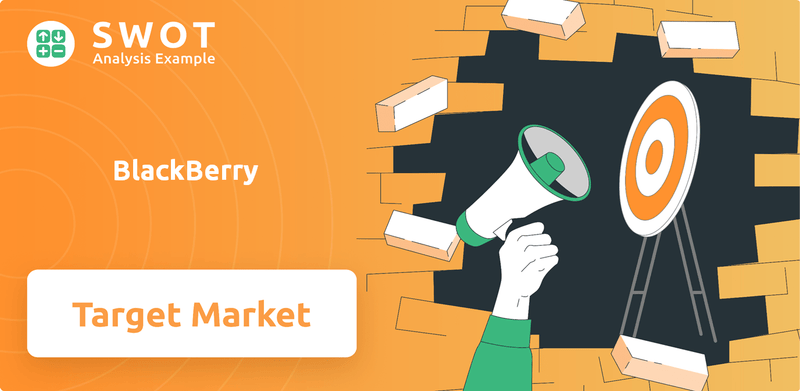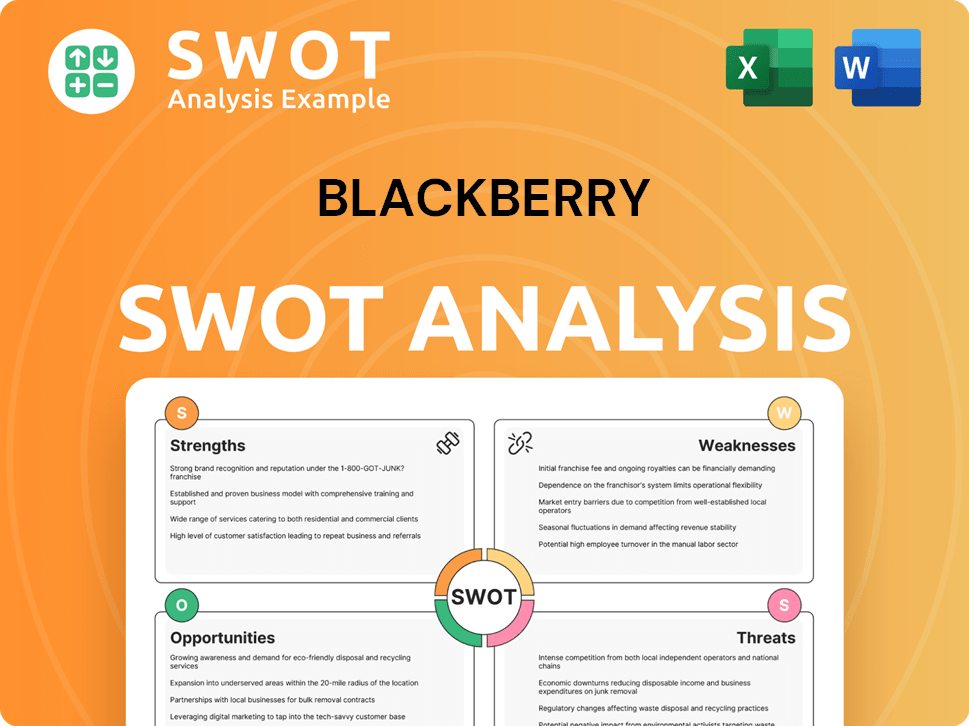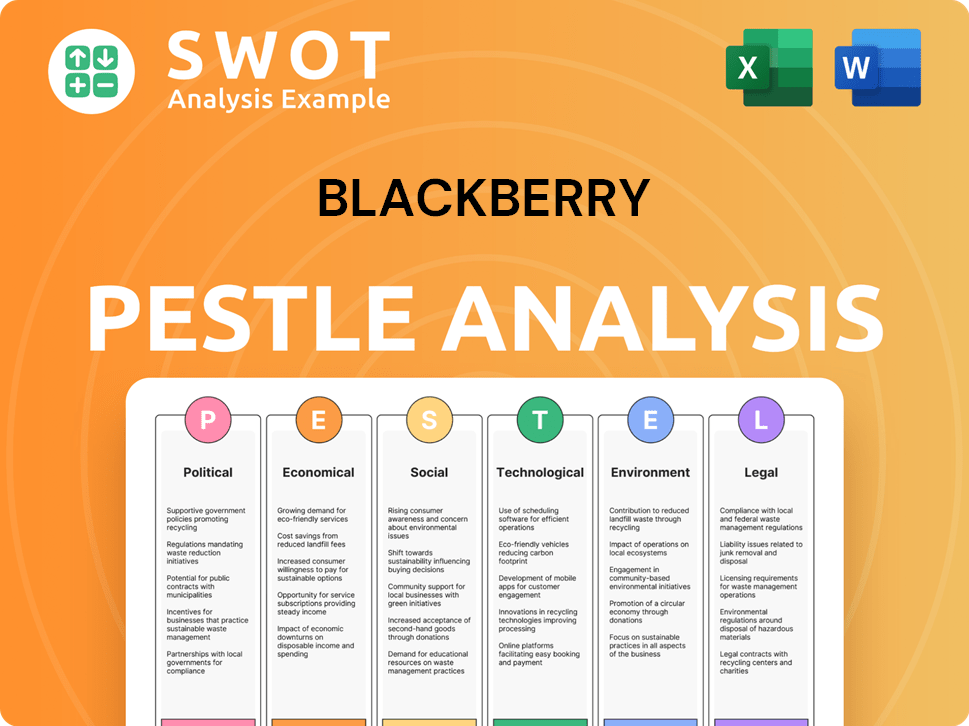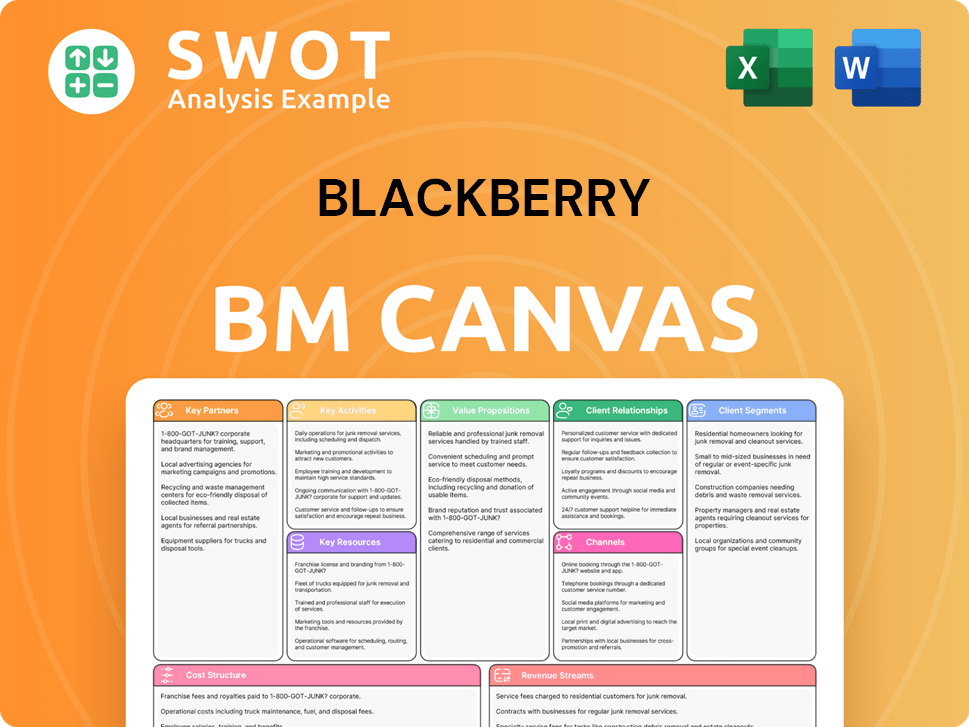BlackBerry Bundle
Can BlackBerry's Transformation Teach Us About Adapting to Change?
From dominating the early smartphone era to reinventing itself, BlackBerry's journey offers a compelling case study in market adaptation. Understanding the evolution of BlackBerry SWOT Analysis, its customer base, and its target market is crucial for anyone seeking to navigate the complexities of today's business landscape. This analysis explores how BlackBerry shifted its focus, adapting to new technologies and consumer preferences to survive and thrive.

This deep dive into BlackBerry's current customer base and market segmentation will reveal the company's strategic pivots. We'll explore the BlackBerry user profile, examining how the company has redefined its audience and tailored its offerings to meet the needs of its core customers. This includes a detailed look at BlackBerry's market position and demographics, offering insights into its enterprise solutions and how it competes in the cybersecurity and IoT sectors. Further analysis of BlackBerry customer demographics, and the company's target market will provide valuable insights for business strategists and investors alike.
Who Are BlackBerry’s Main Customers?
Understanding the BlackBerry customer demographics and target market is crucial for analyzing the company's strategic direction. The company has shifted its focus from consumer hardware to business-to-business (B2B) software and services. This strategic pivot has reshaped its customer profile, emphasizing the needs of enterprises and government entities.
The primary customer segments for BlackBerry are not defined by typical consumer demographics like age or gender. Instead, they are categorized by organizational size, industry, and security requirements. This approach allows BlackBerry to concentrate on high-value markets where its specialized offerings, particularly in security and embedded systems, provide significant advantages.
The core of BlackBerry's target market includes large corporations, government agencies, and organizations in highly regulated industries. These sectors demand robust security and reliability, aligning perfectly with BlackBerry's strengths. This focus enables the company to maintain a strong market position and cater to specific needs within the cybersecurity and IoT markets.
These organizations often require advanced security solutions to protect sensitive data and ensure secure communications. BlackBerry provides endpoint security solutions through Cylance AI and secure communication tools. The company's focus on these areas helps define its ideal customer within the enterprise sector.
Government entities prioritize security and reliability for their critical infrastructure and communications. BlackBerry offers solutions like AtHoc for critical event management. This segment represents a significant portion of BlackBerry's revenue, highlighting its market position.
Industries such as automotive, financial services, and healthcare require robust security and compliance measures. BlackBerry's QNX software, embedded in over 250 million vehicles globally as of early 2024, demonstrates its strong presence in the automotive sector. This focus allows BlackBerry to cater to specific needs within these high-growth areas.
BlackBerry's QNX software is a key component in mission-critical applications, particularly in the automotive and industrial IoT sectors. This focus on embedded systems provides a significant value proposition. This strategic move has allowed BlackBerry to identify and cater to high-growth areas.
BlackBerry's customer segmentation strategies are centered on B2B clients seeking advanced security and embedded systems solutions. The company's shift from consumer hardware to software and services has allowed it to focus on high-growth areas.
- Large Corporations: Require advanced security solutions.
- Government Agencies: Prioritize secure communications and infrastructure.
- Regulated Industries: Automotive, financial services, and healthcare.
- Embedded Systems: QNX software for mission-critical applications.
BlackBerry SWOT Analysis
- Complete SWOT Breakdown
- Fully Customizable
- Editable in Excel & Word
- Professional Formatting
- Investor-Ready Format

What Do BlackBerry’s Customers Want?
Understanding the customer needs and preferences is crucial for a comprehensive BlackBerry company analysis. The company's focus on security and reliability significantly shapes its target market and product development strategies. This approach is particularly evident in its business-to-business (B2B) offerings, where these factors are paramount.
BlackBerry's B2B customers prioritize robust security, reliability, and compliance. Their purchasing decisions are driven by thorough evaluations, involving multiple stakeholders. Long-term value and total cost of ownership are key considerations. Data protection, threat prevention, and adherence to regulatory standards are critical decision-making criteria.
The BlackBerry user profile is often characterized by a demand for secure and dependable communication solutions. This focus is reflected in the company's product development and marketing strategies. These strategies are designed to meet the specific needs of its target audience.
BlackBerry's B2B customers require robust security, reliability, and compliance. These needs are central to their operations and heavily influence purchasing decisions. This is a critical aspect of the BlackBerry target market.
Purchasing behaviors involve thorough evaluation processes. These processes often include multiple stakeholders. The focus is on long-term value and the total cost of ownership.
Decision-making criteria heavily revolve around data protection and threat prevention. Operational continuity and adherence to regulatory standards are also key. These factors are crucial for BlackBerry's success.
Psychological drivers include the assurance of data integrity and the mitigation of cyber risks. These are paramount for enterprises and governments. These factors are essential for understanding BlackBerry customer demographics.
Practical drivers involve seamless integration with existing IT infrastructure. Ease of management and scalability are also key. These are important considerations for BlackBerry's solutions.
BlackBerry addresses common pain points such as ransomware attacks and data breaches. Insecure communication channels are also addressed through its AI-driven cybersecurity solutions. This is a key aspect of BlackBerry's market position.
BlackBerry tailors its offerings to diverse industry-specific needs. This is achieved through specialized products and a deep understanding of customer requirements. The company's focus on security and reliability is evident in its product development and market strategies.
- Automotive Sector: Customers prioritize safety and security in embedded systems, making QNX a preferred choice.
- AI-Driven Cybersecurity: BlackBerry Cylance uses AI to predict and prevent cyberattacks.
- Critical Event Management: Products like BlackBerry AtHoc are designed for government and public sector use.
- Market Trends: Escalating cyber threats and connected devices influence product development, leading to continuous innovation. For more insights, you can read a Brief History of BlackBerry.
BlackBerry PESTLE Analysis
- Covers All 6 PESTLE Categories
- No Research Needed – Save Hours of Work
- Built by Experts, Trusted by Consultants
- Instant Download, Ready to Use
- 100% Editable, Fully Customizable

Where does BlackBerry operate?
BlackBerry Limited maintains a significant global geographical market presence, focusing on major economic regions and countries with strong enterprise and government sectors. Its market reach is influenced by the adoption rate of connected technologies and the regulatory landscape governing data security and privacy. The company's focus on securing the 'Enterprise of Things' shapes its market presence, driven by the global proliferation of connected devices and the need for secure management across various industries and geographies.
The strongest market share and brand recognition are typically found in North America, particularly the United States and Canada, and in European countries. These regions often have stringent regulatory environments and a high demand for advanced cybersecurity and IoT solutions, aligning with BlackBerry's core offerings. Differences in customer demographics, preferences, or buying power across these regions are addressed through localized sales teams, partnerships, and tailored product configurations.
The company strategically expands into emerging markets with growing digital infrastructure and increasing cybersecurity concerns while maintaining its established presence in mature markets. Its QNX software, for example, has a pervasive presence in the automotive industry worldwide, with over 250 million vehicles globally embedding its technology, indicating a strong international footprint in this sector. For more insights into the company's performance, you can explore Owners & Shareholders of BlackBerry.
BlackBerry's primary market is in North America, particularly the United States and Canada. This region is crucial due to its strong enterprise and government sectors. The demand for cybersecurity and IoT solutions is high, aligning with BlackBerry's core offerings.
BlackBerry also has a significant presence in European countries. These regions often have stringent regulatory environments, such as GDPR, which impacts its cybersecurity offerings. BlackBerry tailors its products to meet regional data privacy regulations.
BlackBerry is expanding its reach into emerging markets within the Asia-Pacific region. This expansion is driven by growing digital infrastructure and increasing cybersecurity concerns. The company is adapting to the diverse needs of these markets.
BlackBerry's QNX software is a key component in the global automotive industry. Its technology is embedded in over 250 million vehicles worldwide. This widespread use highlights its strong international footprint in this sector.
BlackBerry Business Model Canvas
- Complete 9-Block Business Model Canvas
- Effortlessly Communicate Your Business Strategy
- Investor-Ready BMC Format
- 100% Editable and Customizable
- Clear and Structured Layout

How Does BlackBerry Win & Keep Customers?
The customer acquisition and retention strategies of the company are primarily focused on its B2B model. This approach leverages a multi-faceted strategy that emphasizes direct sales, strategic partnerships, and thought leadership in cybersecurity and IoT. Marketing efforts heavily involve digital platforms, including content marketing, webinars, and targeted online advertising to reach IT decision-makers and C-suite executives. Traditional channels, such as industry conferences and trade shows, also play a crucial role in lead generation and relationship building. For instance, the company frequently participates in major cybersecurity events to showcase its latest Cylance AI solutions and network with potential clients.
Sales tactics involve a consultative approach, where sales teams work closely with organizations to understand their specific security and operational challenges and propose tailored solutions. The company utilizes customer data and CRM systems to segment its target audience and personalize outreach, ensuring that marketing messages and sales pitches are highly relevant to the prospective client's industry and needs. Strategic partnerships with system integrators, technology providers, and automotive OEMs are vital for expanding its market reach and embedding its technologies into broader ecosystems. For instance, the widespread adoption of QNX in the automotive industry is largely due to its integration by major car manufacturers.
Customer retention is driven by strong after-sales service, ongoing product innovation, and a focus on customer success. The company offers comprehensive support, training, and regular updates for its software to ensure high customer satisfaction and continued value. Loyalty programs, though not in the traditional consumer sense, manifest as long-term contracts and recurring revenue models for its software and services, reflecting the critical nature of its offerings to enterprise operations. Changes in strategy over time have included a significant pivot from hardware sales to a software and services-centric model, which has positively impacted customer lifetime value by creating more stable, recurring revenue streams and fostering deeper, more strategic relationships with its enterprise clients. This shift has also reduced churn rates associated with hardware refresh cycles.
The company focuses on acquiring customers through direct sales, strategic partnerships, and digital marketing. This approach is tailored to reach IT decision-makers and C-suite executives. The company uses a consultative sales approach, understanding client needs to offer tailored solutions. For more insights, see the Growth Strategy of BlackBerry.
- Direct Sales: The company's sales teams work directly with businesses to understand their security and operational needs.
- Strategic Partnerships: Collaborations with system integrators and technology providers expand market reach.
- Digital Marketing: Content marketing, webinars, and targeted online advertising are used to reach the target audience.
- Industry Events: Participation in cybersecurity conferences and trade shows helps in lead generation.
Customer retention is achieved through strong after-sales service, continuous product innovation, and a focus on customer success. The company provides comprehensive support, training, and regular software updates. This strategy builds long-term relationships, emphasizing the value of their services to enterprise clients.
- After-Sales Service: Comprehensive support and training are provided to ensure customer satisfaction.
- Product Innovation: Continuous updates and new features keep products competitive and valuable.
- Customer Success: Focus on helping customers achieve their goals through the company's solutions.
- Recurring Revenue: Long-term contracts and services create stable revenue streams.
Marketing efforts are concentrated on digital platforms and industry events. Digital channels include content marketing, webinars, and online advertising, while industry conferences and trade shows facilitate direct engagement.
The company employs a consultative sales approach, working closely with clients to understand their needs and offer tailored solutions. This involves using customer data and CRM systems for targeted outreach.
Partnerships with system integrators, technology providers, and automotive OEMs are essential for market expansion. These collaborations help embed technologies into broader ecosystems.
Comprehensive support, training, and regular software updates are provided to ensure high customer satisfaction. This helps maintain long-term relationships with enterprise clients.
The company has transitioned to a software and services-centric model, which generates recurring revenue. This shift has improved customer lifetime value and reduced churn rates.
The primary focus is on the B2B market, specifically targeting industries that require robust cybersecurity solutions. This includes automotive, government, and financial sectors.
BlackBerry Porter's Five Forces Analysis
- Covers All 5 Competitive Forces in Detail
- Structured for Consultants, Students, and Founders
- 100% Editable in Microsoft Word & Excel
- Instant Digital Download – Use Immediately
- Compatible with Mac & PC – Fully Unlocked

Related Blogs
- What are Mission Vision & Core Values of BlackBerry Company?
- What is Competitive Landscape of BlackBerry Company?
- What is Growth Strategy and Future Prospects of BlackBerry Company?
- How Does BlackBerry Company Work?
- What is Sales and Marketing Strategy of BlackBerry Company?
- What is Brief History of BlackBerry Company?
- Who Owns BlackBerry Company?
Disclaimer
All information, articles, and product details provided on this website are for general informational and educational purposes only. We do not claim any ownership over, nor do we intend to infringe upon, any trademarks, copyrights, logos, brand names, or other intellectual property mentioned or depicted on this site. Such intellectual property remains the property of its respective owners, and any references here are made solely for identification or informational purposes, without implying any affiliation, endorsement, or partnership.
We make no representations or warranties, express or implied, regarding the accuracy, completeness, or suitability of any content or products presented. Nothing on this website should be construed as legal, tax, investment, financial, medical, or other professional advice. In addition, no part of this site—including articles or product references—constitutes a solicitation, recommendation, endorsement, advertisement, or offer to buy or sell any securities, franchises, or other financial instruments, particularly in jurisdictions where such activity would be unlawful.
All content is of a general nature and may not address the specific circumstances of any individual or entity. It is not a substitute for professional advice or services. Any actions you take based on the information provided here are strictly at your own risk. You accept full responsibility for any decisions or outcomes arising from your use of this website and agree to release us from any liability in connection with your use of, or reliance upon, the content or products found herein.